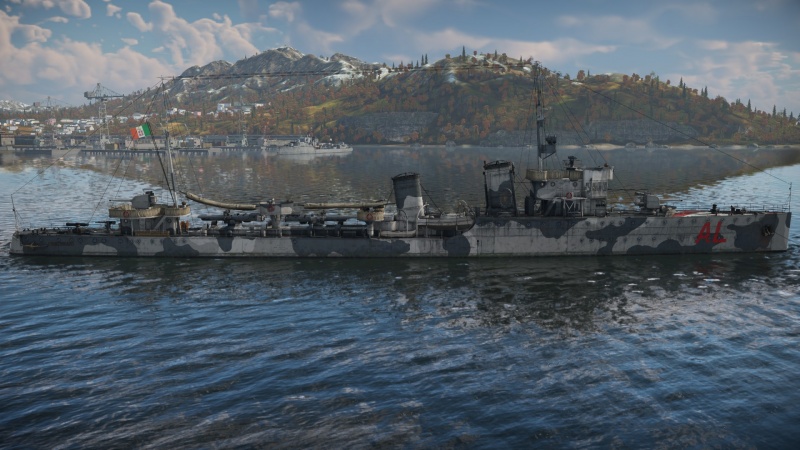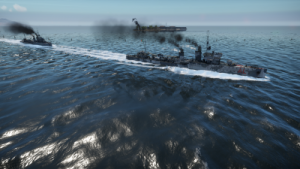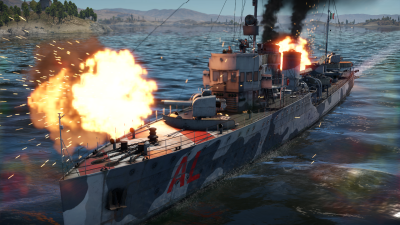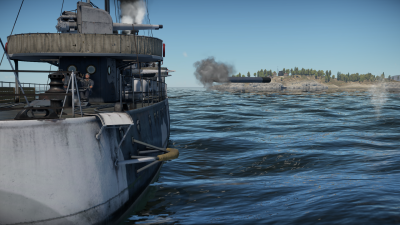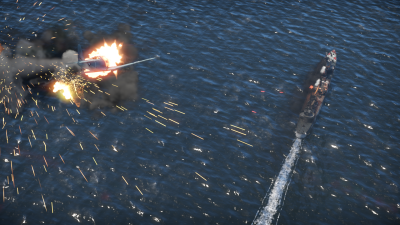RN Aquilone
| This page is about the Italian Destroyer RN Aquilone. For other versions, see Turbine (Family). |
Contents
Description
RN Aquilone was a Turbine-class destroyer laid down for the Regia Marina on 18 May 1925. She was launched on 3 August 1927, completed and commissioned on 3 December 1927, and assigned in 1929 to the 1°Divisione Navale. Between 1936-1937, she participated in the Spanish Civil War. Despite the wear on the ship by this time, she also participated in WWII, with particular combat in the seas of Libya and several battles around Tobruk. While sailing to Tripoli on 17 September 1930, Aquilone hit naval mines that were not visible in the fog, and quickly sank.
Introduced in Update "New Power", Turbine-class, RN Aquilone, 1939 has very good manoeuvrability and speed. With the same armament as RN Turbine, the two dual 120 mm turrets can cause good damage with the HE shells, while also being capable of handling more armoured targets with the AP shells. The anti-aircraft armament is composed by three 40 mm Vickers-Terni cannons; the HE-FT are ineffective at medium and long ranges, but can provide quite a punch to enemy boats and incoming enemy aircraft at shorter ranges.
General info
Survivability and armour
RN Aquilone compared to the other ships of its rating is the smallest, with a hull of 91 m compared to the 140 m of the British Town-class or the 103 m of the Mutsuki, but even if it is the smallest ship it defends itself well.
It is protected with 16 mm of steel on the hull. Her low-profile hull makes her very difficult to hit over long distances, but at the same time she is very agile and fast.
Thanks to her intrepid crew of 179 sailors she takes first place as the most manned ship at her battle rating, in second place we find the Frunze with 168 members and in third place we find the USS Litchfield. These ships mentioned above will also be the most present along with the Leopard in battle, the advantage is that all three have one thing in common, they all have little protection on the main hull.
The Litchfield and the Leopard are the most vulnerable because right next to the hold they have the principal fuel tank, something that the Frunze does not have.
Unfortunately, Aquilone also has this flaw, which is a problem because during combat the front of the ship is one of the most vulnerable. To remedy this flaw, it is recommended that the ship be angled slightly to the left or right in the direction of enemy fire, so that the enemy rounds do not find a flat surface to penetrate and blow Aquilone to oblivion.
Mobility
Aquilone is equipped with 2 powerful turbines that deliver 40,000 horsepower, taking it up to 36 knots (66 km/h). Its draught of only 3 m makes it very agile even at maximum speed. Its rudder can turn from left to right and vice versa in just 5 seconds.
The advantage of being small and wide increases the stability of the ship even in case of a sudden turn. Aquilone, once it reaches maximum speed, is able to stop completely in 32 seconds and its maximum speed in reverse is -14 knots (-26 km/h).
| Mobility Characteristics | |||
|---|---|---|---|
| Game Mode | Upgrade Status | Maximum Speed (km/h) | |
| Forward | Reverse | ||
| AB | |||
| Upgraded | |||
| RB/SB | |||
| Upgraded | |||
Modifications and economy
Armament
Primary armament
First produced by Ansaldo in 1926, this gun was continually modified during the 1930s by both Ansaldo and Odero-Terni-Orlando (OTO). The 120 mm/45 O.T.O. Mod. 1926 in the double mounts suffered from excessive dispersion which seems to be the result of mounting the barrels too close together. On later destroyers, a single 120 mm/50 (4.7") mount was used to replace the obsolete 120 mm/15 (4.7") star shell howitzers, thus improving the ship's firepower.
In combat this type of weapon is very strong at its battle rating, as the ammunition it can offer are HE, APHE, and HE-TF. The speed of the rounds are 850 m/s and are fired with a frequency of 8.2 seconds. HE and HE-TF have an explosive mass of 2.39 kg and APHE 1.16 kg.
The HEs which Aquilone can use are currently the most explosive of the early destroyers, the Frunze only has 2.1 kg, the Leopard has 2 kg, the IJN Mutsuki 1.86 kg, the USS Litchfield 1.23 kg and the HMS Churchill with only 721 g. The great velocity of its rounds almost guarantees an almighty success in long-distance fights.
| Penetration statistics | |||||||
|---|---|---|---|---|---|---|---|
| Ammunition | Type of warhead |
Penetration @ 0° Angle of Attack (mm) | |||||
| 1,000 m | 2,500 m | 5,000 m | 7,500 m | 10,000 m | 15,000 m | ||
| HE Dirompente | HE | 29 | 29 | 29 | 29 | 29 | 29 |
| APBC Perforante | APHE | 154 | 121 | 81 | 56 | 41 | 35 |
| HE-TF Contro-aerea | HE-TF | 29 | 29 | 29 | 29 | 29 | 29 |
| Shell details | ||||||||||||
|---|---|---|---|---|---|---|---|---|---|---|---|---|
| Ammunition | Type of warhead |
Velocity (m/s) |
Projectile mass (kg) |
Fuse delay (s) |
Fuse sensitivity (mm) |
Explosive mass (TNT equivalent) (kg) |
Ricochet | |||||
| 0% | 50% | 100% | ||||||||||
| HE Dirompente | HE | 850 | 22.11 | 0 | 0.1 | 2.39 | 79° | 80° | 81° | |||
| APBC Perforante | APHE | 850 | 23.15 | 0.025 | 6 | 1.16 | 47° | 60° | 65° | |||
| HE-TF Contro-aerea | HE-TF | 850 | 22.11 | 0 | 0.1 | 2.39 | 79° | 80° | 81° | |||
Secondary armament
Introduced into the Royal Navy in March 1915 as a large calibre MG AA. These guns used 25-round fabric belts, which are used only in single mounts. Britain produced a total of 795 cannons of which 577 were still available in 1939.
The original Mark II design was prone to many defects and the Mark II* was a modified version that improved reliability. Stoppages and jams were still common in these models as the bullets slipped out of their mounts and the fabric belts which carried them often tore. The Mark II*C was another modification that used a 14-shot steel-link belt instead of the fabric belt. These steel-mesh belts were also used on the later 2-pdr. Mark VIIIs. About 50 of these guns were sold to the Italian Navy. They were then manufactured under license by Terni (Italy) until the early 1930s. The Terni version used a 50-round ammunition box.
Aquilone is equipped with no less than three 40 mm/39 Vickers-Terni mod.1915/1917 guns, 2 in the center and 1 in the rear of the ship. This positioning guarantees complete aerial coverage within a radius of 1.1 km. Unfortunately, their short range limits the air defense of the ship, but as soon as an air target enters the maximum effective range of these anti-aircraft guns, i.e. 800 m, the aircraft will be instantly neutralized by the HE-TF rounds which use 31 g of explosive.
| Penetration statistics | |||||||
|---|---|---|---|---|---|---|---|
| Ammunition | Type of warhead |
Penetration @ 0° Angle of Attack (mm) | |||||
| 10 m | 100 m | 500 m | 1,000 m | 1,500 m | 2,000 m | ||
| 40 mm HE-TF | HE-TF | 3 | 3 | 3 | 3 | 3 | 3 |
| Shell details | ||||||||||||
|---|---|---|---|---|---|---|---|---|---|---|---|---|
| Ammunition | Type of warhead |
Velocity (m/s) |
Projectile mass (kg) |
Fuse delay (m) |
Fuse sensitivity (mm) |
Explosive mass (TNT equivalent) (g) |
Ricochet | |||||
| 0% | 50% | 100% | ||||||||||
| 40 mm HE-TF | HE-TF | 610 | 0.92 | 0 | 0.1 | 31 | 79° | 80° | 81° | |||
Additional armament
Aquilone is equipped with 6 torpedoes 533 mm S.I. 250/533,4X7,5 Tipo A and 52 Bollo P.125/1932 mines. The torpedo launchers are arranged in a linear fashion in the central part of the ship and have a range of 180 degrees on both sides of the ship.The torpedoes without the improved torpedo modification have a range of 4 km and travel at 76 km/h, while with the modification installed the torpedoes increase the range to 12 km, however their speed is reduced to 48 km/h.
These torpedoes have a mass of 1,781 kg and inside they contain 250 kg of explosives. After their launch, they need 50 m to arm themselves and become destructive.
The 52 mines are placed in the rear of the ships carried on rails that start from the middle of the ship and go all the way to the stern. The mines in question have a mass of 221 kg of which 125 kg of explosives alone, once released into the sea these mines will stay stationary to float and will not detonate until a ship goes very close.
Usage in battles
Aquilone at its battle rating has a good armament composed of 4 120 mm/45 O.T.O. Mod. 1926 cannons, that can cause heavy damage to enemy ships, using HE rounds that can destroy lightly-armoured enemy ships with a single shot, or the APHE rounds that are better suited against armour but can still cause massive amounts of damage to destroyers and destroy them in a few shots, by aiming for their unarmoured or weakly protected areas.
Using the main armament for anti-aircraft purposes, you can use the HE-TF shells. These shells detonate near aerial targets, according to the distance calculated by the ship's crew, causing its destruction or serious critical damage. The only con of the main guns is the recharge time of 8.5 seconds. The ship has only 3 anti-aircraft guns (40 mm/39 Vickers-Terni mod.1915/1917) which are very powerful but their range is so low that they are not very good as an anti-aircraft deterrent.
The ship is the smallest reserve destroyer among all reserves of the bluewater ships in the game. The ship has a good speed and good manoeuvrability making the ship able to dodge enemy torpedoes. The ship can also carry mines and torpedoes, the mines are deadly and can cause serious damage to destroyers making them sink very quickly, while the torpedoes can be modified with the torpedo mode modification, from stock the torpedoes reach 4 km distance and have a speed of 76 km/h while if you use the modification the torpedoes become much slower 48 km/h, while the distance is increased to 12 km.
Increasing the distance of the torpedoes allows for unsuspecting enemy ships to sail into them or if near a capture zone and enemy vessels are in the cap zone, launch them towards the zone and any ships which they hit will be sunk.
Aquilone should be used as a support ship or for side attacks; its cannons fire slowly but cause serious damage to enemy ships. Do not go to the front because the enemies have the ability to destroy Aquilone easily with a single well-placed shot, the ship is also very small so Aquilone is a difficult target to hit, when sailing towards the enemy ships - however exposing the broadside will make Aquilone a bigger target to hit.
Pros and cons
Pros:
- Good primary armament (120 mm/45 O.T.O. Mod. 1926).
- Good choice of ammunition for primary armament (APHE, HE, HE-TF).
- Good survivability (179 of crew).
- Good speed (67 km/h).
- Good manoeuvrability (approx. 45 seconds for a complete circle).
- Good torpedoes range 12 km with torpedo mode modification.
- Good velocity torpedoes (76 km/h) without Torpedo mode modification.
Cons:
- Slow turn rate of AA guns with 40 mm/39 Vickers-Terni mod.1915/1917.
- Short range AA guns with 40 mm/39 Vickers-Terni mod.1915/1917.
- The ammo rack can explode easily when hit, causing the ship to explode!
- Slow reload for the primary armament it reloads in 8,5 seconds
- Slow torpedoes, only 48 km/h of speed with torpedo mode modification.
- Very short range torpedoes (4 km) without torpedo mode modification.
- Carrying mines, if the ship is hit in the mine they will do an ammo rack explosion on the ship resulting in the total destruction of Aquilone.
History
Turbine-class
The Turbine-class comprised 8 destroyers named after winds (Turbine, Borea, Nembo, Aquilone, Euro, Espero, Zeffiro, and Ostro). It was one of the first classes of military ships after the First World War. This class succeeded fairly well, they had 2 twin turrets with 120 mm/45 O.T.O. Mod. 1926 guns with 6 torpedoes for auxiliary armament.
They fought in the war, but suffered 6 losses by 1940 and the other 2 sank after the armistice of 8 September.
The Turbine-class ships presented characteristics that can be defined as intermediate between the ships of the first post-war period and those of the 1930s. They were launched in 1927-28, and compared to their predecessors had a hull lengthened by 3 m, so as to be able to accommodate a 10% more powerful propulsion apparatus.
Propulsion was given by 2 groups of steam turbines on 2 axles, each on a funnel of different sizes (the front funnel was larger) with a modest 40,000 horsepower. The torpedo launchers were 2 triple mounts of 533 mm, there were also depth charges and, similarly to the other ships of the type in service in the Regia Marina, up to 50 mines could be carried.
The main armament was based on 2 twin turrets of 120 mm/45 O.T.O. Mod. 1926 cannons.The twin cannons allowed for a much more compact design of the ships than 4 single installations, and certainly also contributed to the aesthetic harmony of the design, more compact and powerful, but the cannons very close together interfered with each other during fire, causing a dispersion of fire that haunted the naval engineers throughout the war.
Turbine-class ships:
- RN Turbine (1927)
- RN Borea (1927)
- RN Nembo (1927)
- RN Aquilone (1927)
- RN Euro (1927)
- RN Espero (1928)
- RN Zeffiro (1928)
- RN Ostro (1928)
RN Aquilone
RN Aquilone (1927) built by the Odero Shipyard, entered into service on December 3, 1927. In 1929 RN Aquilone constituted, together with the twins RN Turbine, Euro, and Nembo, the II Squadron of the 1st Flotilla of the I Division of Torpedoes, framed in the 1st Naval Squadron, based in La Spezia, the ship participated in some cruises in the Mediterranean from 1929 to 1932.
The crew of RN Aquilone was commanded by Lieutenant Commander Enrico Baroni.
In 1931 RN Aquilone, Turbine, Ostro, Borea, Daniele Manin, Giovanni Nicotera, and Esploratore Pantera formed the 1st Battleship Destroyer Flotilla assigned to the 2nd Division of the 1st Squadron.
In 1932 the same year RN Aquilone accidentally hit Zeffiro with one of its torpedoes (the weapon was defective).
In 1934 RN Aquilone, together with Turbine, Euro, and Nembo, constituted the VIII Destroyer Squadron, assigned, together with the IV (composed by the other four units of the Turbine-class) and the II Naval Division (heavy cruisers RN Fiume and Gorizia).
In 1936-1937, the destroyer took part in the Spanish Civil War.
On 15 December 1938, the destroyer risked capsizing due to rough seas and suffered serious damage, including the removal of a cage containing depth charges and several doors of the dynamo and machine rooms, as well as damage to the motorboat, which risked ending up in the sea.
In November 1939 RN Aquilone returned to Italy, reaching Fiume, where, with the crew reduced to one third, it was subjected to work in dry dock, which included the repair of damage caused by storms. In April, RN Aquilone went to Tobruk to do shooting exercises, both by day and by night, with night navigations along the coast. Starting from 20 May 1940, RN Aquilone participated in the mine operations of the access routes to Tripoli, Tobruk and Benghazi. Between 6 June and 10 July, the four units of the Squadron, together with the minelayer Barletta, laid 14 minefields in Libyan waters, for a total of 540 mines.
At the entrance of Italy in the Second World War, RN Aquilone, Turbine, Euro, and Nembo of the Turbine-class were already old and had a lower top speed because with all the service that made the hull was so worn that it showed that the ship could not reach 36 knots but arrived at a maximum speed of 31 knots.
RN Aquilone from 11 June fought against several British air raids at Tobruk, the ship used her 40 mm/39 Vickers-Terni mod.1915/1917 guns against the enemy planes, the destroyer was not hit.
Although never hit directly, the destroyer had numerous holes in her hull, caused by shrapnel and bombs falling nearby.
On 14 June 1940 RN Aquilone bombarded the British positions at Sollum, together with Nembo and Turbine.
On June 26 the destroyer participated in a second naval bombardment of Sollum. These attacks served to weaken the British defenses in order to make an Italian incursion possible.
On 28 June 1940 the crew of RN Aquilone witnessed the shooting down of Italo Balbo's plane over the skies of Tobruk.
In Tobruk during the torpedo attacks of 5 and 19 July 1940, the destroyers RN Zeffiro, Nembo, and Ostro, as well as the steamers Manzoni and Sereno, were sunk, while Euro and the steamers Liguria and Serenitas were seriously damaged. RN Aquilone remained unharmed, and at the end of August Aquilone was transferred to Benghazi, since Tobruk was by now considered too exposed to air attacks.
On 17 September at 20:15, RN Aquilone and Turbine sailed to Tripoli, again with the intent to decentralize part of the ships concentrated in a port, that of Benghazi, also too exposed to air attacks.
Shortly after having passed through the entrance of the port, at 20:45, when the two units had already passed the area indicated by the buoy of more than one mile, RN Aquilone, which was proceeding behind Turbine, was shaken by two explosions in rapid succession, one in the middle of the ship and one at the stern, tipping over and finding itself with its bridge lying on the sea's surface. The rudder was jammed, preventing it from manoeuvring, and some men were thrown into the sea by the detonations, which made two rafts unusable.
The ship had been hit by the explosion of two magnetic mines, but at the time many thought it was an attack by aircraft, so much so that the anti-aircraft emplacments on land opened fire, while Turbine began accelerating and zigzagging.
Turbine, after having reduced speed, tried to call Aquilone that resulted in useless as action was made to continue for Tripoli, while from Benghazi came out the units destined to the rescues. On Aquilone, irreparably damaged, it was initially ordered to move to the coast, then, again by order of Commander Agostini, the machines were stopped and the aft ammunition depots were flooded, then the boats were put to sea, one of which, after being lowered, capsized because of the rough sea. As a result of the explosion, the starboard depth charges fell into the water, but thanks to the shallow depth (13-15 m) they did not detonate. The abandonment of the ship, surrounded by fuel oil leaking from the tanks, took place in an orderly manner, thus limiting losses.
After having heartened the crew, Captain Agostini remained on board, until he was dragged into the sea by a wave. Bumping against the bottom, Aquilone laid down on the seabed.
Despite the rapidity of the sinking and the rough sea, the human losses were rather limited, consisting of 4 dead, 9 missing and 20 injured (the latter caused mainly by the impact against the ship's structures immediately after the explosions).
The search - directed, starting from about 23:30, by Commander Agostini, decorated on that occasion with the MAVM (Silver Medal for Military Valor), recovered from a lifeboat of the old torpedo boat Abba after two and a half hours spent adrift - lasted until 2 a.m. on the 18th and led to the rescue of the remaining crew (some shipwrecked, in the water or on rafts, were found after six hours from the sinking), then brought on board the hospital ship California and to the Colonial Hospital of Benghazi. After what happened to Aquilone the port of Benghazi was temporarily blocked: entry and exit of any ship was forbidden until the arrival, from Italy, of a magnetic minesweeper that took care of the demining.
Two survivors of the crew of Aquilone, G. Giannoni and P. L. Fazzi, later donated the crowning light, a short section of the anchor chain and the bow star of Aquilone to the Museum of the Italian Military Memorial of El Alamein.
Media
- Skins
- Images
See also
Links to articles on the War Thunder Wiki that you think will be useful for the reader, for example:
- reference to the series of the ship;
- links to approximate analogues of other nations and research trees.
External links
Paste links to sources and external resources, such as:
- topic on the official game forum;
- other literature.
| Odero-Terni-Orlando Company | |
|---|---|
| Destroyers | |
| Turbine-class | RN Turbine · RN Aquilone |
| Dardo-class | RN Dardo |
| Soldati-class | RN Corazziere · RN Aviere · RN Geniere |
| Comandanti Medaglie d'Oro-class | RN Comandante Margottini |
| Light Cruisers | |
| Condottieri-class | Kerch* · RN Duca degli Abruzzi |
| Capitani Romani-class | RN Attilio Regolo · Guichen** |
| Heavy Cruisers | |
| Trento-class | RN Trento |
| Zara-class | RN Zara · RN Pola |
| Battleships | |
| Conte di Cavour-class | RN Leonardo da Vinci*** |
| Export | Tashkent**** |
| See Also | OTO Melara |
| *RN Duca d'Aosta before war reparation to the USSR | |
| **RN Scipione Africano before war reparation to France | |
| ***Previously ‘’Cantieri navali Odero’’ in Genoa-Sestri Ponente | |
| ****Built for the USSR | |
| Italy destroyers | |
|---|---|
| Regia Marina | |
| Aquila-class | RN Aquila |
| Leone-class | RN Leone · RN Tigre |
| Turbine-class | RN Aquilone · RN Turbine |
| Navigatori-class | RN Da Verazzano |
| Dardo-class | RN Dardo |
| Soldati-class | RN Aviere · RN Corazziere · RN Geniere |
| Comandanti Medaglie d'Oro-class | RN Comandante Margottini |
| Marina Militare | |
| Fante-class* | Geniere |
| Indomito-class | Impetuoso |
| * Modified Fletcher-class destroyers | |
| Italy premium ships | |
|---|---|
| Motor torpedo boats | Freccia P-493 · MAS 569 · MS 444 · MC 485 |
| Motor gun boats | Sparviero |
| Sub-chasers | Folaga |
| Destroyers | RN Aquilone · RN Aviere · RN Geniere · RN Tigre · Geniere |
| Heavy cruisers | RN Pola |
| Battleships | RN Leonardo da Vinci |



